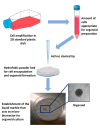Current Advances in 3D Tissue and Organ Reconstruction
- PMID: 33467648
- PMCID: PMC7830719
- DOI: 10.3390/ijms22020830
Current Advances in 3D Tissue and Organ Reconstruction
Abstract
Bi-dimensional culture systems have represented the most used method to study cell biology outside the body for over a century. Although they convey useful information, such systems may lose tissue-specific architecture, biomechanical effectors, and biochemical cues deriving from the native extracellular matrix, with significant alterations in several cellular functions and processes. Notably, the introduction of three-dimensional (3D) platforms that are able to re-create in vitro the structures of the native tissue, have overcome some of these issues, since they better mimic the in vivo milieu and reduce the gap between the cell culture ambient and the tissue environment. 3D culture systems are currently used in a broad range of studies, from cancer and stem cell biology, to drug testing and discovery. Here, we describe the mechanisms used by cells to perceive and respond to biomechanical cues and the main signaling pathways involved. We provide an overall perspective of the most recent 3D technologies. Given the breadth of the subject, we concentrate on the use of hydrogels, bioreactors, 3D printing and bioprinting, nanofiber-based scaffolds, and preparation of a decellularized bio-matrix. In addition, we report the possibility to combine the use of 3D cultures with functionalized nanoparticles to obtain highly predictive in vitro models for use in the nanomedicine field.
Keywords: 3D matrices; 3D printing and bioprinting; biomechanical cues; decellularization; hydrogel; micro-bioreactor; microenvironment remodeling; nanofiber-based scaffolds; nanomedicine; tissue engineering.
Conflict of interest statement
The authors declare no conflict of interest.
Figures





Similar articles
-
Bioprinting of 3D hydrogels.Lab Chip. 2015 Aug 7;15(15):3111-5. doi: 10.1039/c5lc90069g. Lab Chip. 2015. PMID: 26066320
-
High Throughput Bioprinting Using Decellularized Adipose Tissue-Based Hydrogels for 3D Breast Cancer Modeling.Macromol Biosci. 2024 Aug;24(8):e2400035. doi: 10.1002/mabi.202400035. Epub 2024 Apr 29. Macromol Biosci. 2024. PMID: 38685795
-
Three-Dimensional Bioprinting of Decellularized Extracellular Matrix-Based Bioinks for Tissue Engineering.Molecules. 2022 May 26;27(11):3442. doi: 10.3390/molecules27113442. Molecules. 2022. PMID: 35684380 Free PMC article. Review.
-
Tissue-Specific Hydrogels for Three-Dimensional Printing and Potential Application in Peripheral Nerve Regeneration.Tissue Eng Part A. 2022 Feb;28(3-4):161-174. doi: 10.1089/ten.TEA.2021.0093. Epub 2022 Jan 5. Tissue Eng Part A. 2022. PMID: 34309417
-
Strategies for improving the 3D printability of decellularized extracellular matrix bioink.Theranostics. 2023 Apr 23;13(8):2562-2587. doi: 10.7150/thno.81785. eCollection 2023. Theranostics. 2023. PMID: 37215563 Free PMC article. Review.
Cited by
-
A Novel 3D Culture Model of Human ASCs Reduces Cell Death in Spheroid Cores and Maintains Inner Cell Proliferation Compared With a Nonadherent 3D Culture.Front Cell Dev Biol. 2021 Nov 11;9:737275. doi: 10.3389/fcell.2021.737275. eCollection 2021. Front Cell Dev Biol. 2021. PMID: 34858974 Free PMC article.
-
Hydrogel modification of 3D printing hybrid tracheal scaffold to construct an orthotopic transplantation.Am J Transl Res. 2022 May 15;14(5):2910-2925. eCollection 2022. Am J Transl Res. 2022. PMID: 35702071 Free PMC article.
-
The Antianginal Drug Perhexiline Displays Cytotoxicity against Colorectal Cancer Cells In Vitro: A Potential for Drug Repurposing.Cancers (Basel). 2022 Feb 18;14(4):1043. doi: 10.3390/cancers14041043. Cancers (Basel). 2022. PMID: 35205791 Free PMC article.
-
Novel Ground-Up 3D Multicellular Simulators for Synthetic Biology CAD Integrating Stochastic Gillespie Simulations Benchmarked with Topologically Variable SBML Models.Genes (Basel). 2023 Jan 6;14(1):154. doi: 10.3390/genes14010154. Genes (Basel). 2023. PMID: 36672895 Free PMC article.
-
Drug-free in vitro activation combined with 3D-bioprinted adipose-derived stem cells restores ovarian function of rats with premature ovarian insufficiency.Stem Cell Res Ther. 2022 Jul 26;13(1):347. doi: 10.1186/s13287-022-03035-3. Stem Cell Res Ther. 2022. PMID: 35883196 Free PMC article.
References
-
- Harrison R.G., Greenman M.J., Mall F.P., Jackson C.M. Observations of the living developing nerve fiber. Anat. Rec. 1907;1:116–128. doi: 10.1002/ar.1090010503. - DOI
Publication types
MeSH terms
Substances
Grants and funding
LinkOut - more resources
Full Text Sources
Other Literature Sources
Miscellaneous

